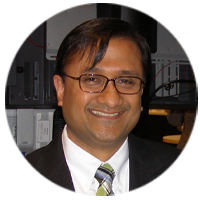
In early 2020, we launched the SIMULIA Champions program. The 2020 SIMULIA Champions are the inaugural team of brand ambassadors, whose expertise and passion position them to advance the future of simulation technology. In this series of blogs, we introduce some of our individual SIMULIA Champions, finding out more about their history – and future – with the technology.
Raja Sengupta is Lead Engineer for Aerodynamics at Volvo Trucks in Greensboro, North Carolina. Volvo primarily manufactures heavy duty trucks, buses, construction equipment and diesel engines as well as marine applications, and is beginning to produce with electric trucks also. Sengupta is responsible for the aerodynamic certification (for CO2) of Volvo’s North American product portfolio and is in charge of aerodynamic development for the SuperTruck II project sponsored by the Department of Energy. The SuperTruck project began in 2011 with a challenge to improve freight efficiency by 50 percent. SuperTruck II doubled that target to 100 percent. Sengupta worked on the original SuperTruck, as well as the ongoing SuperTruck II project, and describes the program as the greatest opportunity of his career.
“The SuperTruck program…represents the pinnacle of all [my] experience—bringing together aerodynamics, cooling, chassis layout, trailer optimization,” he says. “It was a once in a lifetime experience, and I was able to do it twice.”
Most success stories come with great challenges as well. For Sengupta, it has been the need to preserve aerodynamic performance while balancing many other requirements of a truck.
“That’s the crux of a successful product execution, to balance all those features and come up with an optimal product at the end of the day,” he says.
Volvo’s Greensboro office uses PowerFLOW for all its CFD applications, and has been doing so since just before 2007, when Sengupta joined Volvo. Sengupta himself has been using the software since 1999, shortly after completing his PhD in Aerospace Engineering at the University of Cincinnati. After working for two years in aerospace at NASA Langley, he moved onto the motorsports industry, where he encountered PowerFLOW.
“I was completely fascinated by Lattice Boltzmann technology because it was so much more efficient and easy to use compared to the Navier-Stokes-based tools I had used for the previous 10-plus years,” he says.
As a customer of Exa, which was acquired by Dassault Systèmes in 2017, Sengupta was working on some projects using PowerFLOW when he was offered a position at the company in 2001. He worked in multiple areas, including technical sales, support, and validation before moving to the product management group and helping to develop new software for engine cooling and eventually full-truck simulation. In 2004, he was responsible for the first-ever CFD project for Volvo Trucks in North America, beginning a professional relationship that eventually led to his being hired in 2007.
Sengupta says he “naturally gravitated” towards engineering for several reasons. He always loved solving problems and had an affinity for math and physics, and his father was a marine engineer. Sengupta was drawn towards aerospace engineering because he loved flying, and he took flying lessons at the Indian Institute of Technology where he received his Bachelor’s Degree. After his time at NASA, he switched gears and began working in motorsports before moving to Exa and eventually Volvo Trucks.
Sengupta is motivated by the desire to tackle one of the biggest problems facing humanity today: climate change. Heavy trucks represent a large fraction of CO2 emissions in the United States, so reducing those even by five or 10 percent makes a big difference. Because of the higher operating speeds in North America, aerodynamics has a huge impact on fuel consumption, and therefore the carbon footprint, of diesel powered heavy-duty trucks. Sengupta has been able to use PowerFLOW to make great progress in his product development role through programs such as SuperTruck. He also represented Volvo during the development of the Greenhouse Gas (GHG) Phase II emission regulation in discussions about aerodynamics with the EPA, which covered deeply “contentious and technical issues.”
One small success story Sengupta is proud of is the EPA’s acceptance of a surrogate yaw angle that represents the wind-averaged condition per SAE J1252. Sengupta investigated the yaw curves (drag vs. crosswind angle) of many truck configurations and found that the effective yaw angle, at which the drag on a tractor-trailer matches the SAE J1252 wind averaged drag, falls in a narrow band irrespective of the truck model or its aero features. Therefore, in effect, one could obtain the wind averaged drag by simulating just this surrogate angle, rather than a complete sweep of 11 yaw angles as the regulation originally mandated. This reduced the computational burden on the OEMs from 11 simulations per configuration down to 2 (±Ψ, where Ψ is the effective or surrogate yaw angle). This rare win-win scenario satisfied all parties involved.
Outside of work, Sengupta enjoys movies, music, and spending time with his 13-year-old twin sons. Interestingly, Sengupta is a twin himself. Lately, he has been helping his children with online schooling.
SIMULIA is pleased to welcome Raja Sengupta into the 2020 SIMULIA Champions program and excited to continue working with him in the future. Stay tuned to the blog to learn more about our other 2020 SIMULIA Champions.
SIMULIA offers an advanced simulation product portfolio, including Abaqus, Isight, fe-safe, Tosca, Simpoe-Mold, SIMPACK, CST Studio Suite, XFlow, PowerFLOW and more. The SIMULIA Community is the place to find the latest resources for SIMULIA software and to collaborate with other users. The key that unlocks the door of innovative thinking and knowledge building, the SIMULIA Community provides you with the tools you need to expand your knowledge, whenever and wherever.
